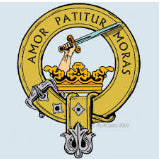
Clan Lumsden
Clan Crest:

Clan Motto:
Amor Patitur Moras (Love Endures Delays)
Tartan:
This is Lumsden Modern.

Selected highlights:
A Lowland clan. The name comes from the manor of Lumsden near Coldingham on the coast of Berwickshire and is first mentioned in a charter in 1098 when Edgar, King of Scotland, son of Malcolm III of Scotland re-founded Coldingham Priory in the county of Berwick. The first people recorded as owning the lands were brothers Gillem and Cren de Lummisden, who sometime between 1166 and 1182 attested a charter by Waldeve, Earl of Dunbar to Coldingham Priory. In 1296, the names of Adam de Lumsden of that Ilk and his son, Roger de Lummesdene appear on the Ragman Rolls (with these spelling variations), as giving forced homage to Edward I of England.
The first recognised chief of Clan Lumsden who descended from Adam was Gilbert de Lumsden - he married the heiress of Blanerne of that Ilk around 1328 and in June 1329 received a charter from the Earl of Angus for the Blanerne lands.
By the mid 14th century, the family had spread, with charters to Conlan in Fife and Medlar and Cushnie in Aberdeenshire. Blanerne Castle (also known as Lumsden Castle) in Duns was acquired in the 14th century. Cushnie in Alford, Pitcairlie Castle in Inverurie, and Tillycairn Castle in Cluny were all owned by the family.
In the mid 1600s three Lumsden brothers fought for the Swedish King, Gustavus Adolphus, with a unit in his service named Lumsden's Musketeers. One of the brothers, James Lumsden of Innergellie returned from this to support the Covenanters; he fought at Marston Moor in 1644, where Charles I was defeated and captured, and at the Battle of Dunbar in 1650, serving under David Leslie. His brother Robert of Mountquhanie defended Dundee against General Monck and was killed on its surrender.
In 1672 the senior line of Lumsden did not register their arms but the two cadet branches of Alexander Lumsden of Cushnie and Sir James Lumsden of Innergellie did register their arms. Today there are thirteen Lumsden families who bear arms, they are all descended from either Alexander or Sir James.
During the Jacobite rising of 1745, Andrew Lumsden, who was grandson of Bishop Andrew Lumsden, the primate of Scotland in the Episcopal Church, was secretary to Charles Edward Stuart. After the Battle of Culloden he was attained and fled to Rome where he became secretary and later Secretary of State to James Francis Edward Stuart (the Old Pretender). The Old Pretender died in 1766 and Lumsden rejoined Prince Charles until 1768. Returning to Scotland in 1773, he was fully pardoned in 1778 by the Hanoverian government. His tartan waistcoat has been preserved at Pitcaple Castle.
Sources:






